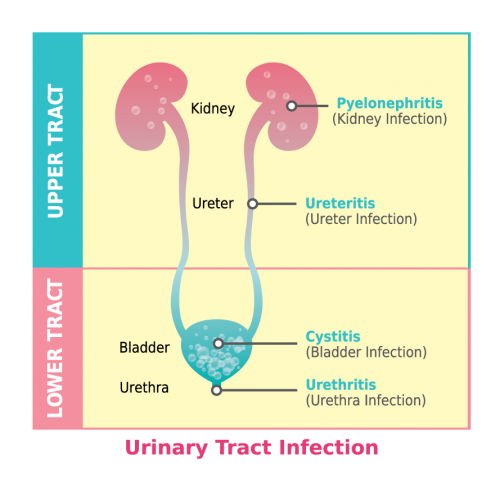What is Urinary Tract Infection(UTI)?
![]()
UTI is an infection in any part of the urinary tract.
Urinary Tract
Urinary tract is our body’s drainage system for removing waste and extra water. It includes:
Kidneys – two bean-shaped organs that make urine out of waste materials from the blood
Ureters – tubes that run from the kidney to the bladder
Bladder – where urine is stored until we go to the toilet
Urethra – the tube from the bladder through which urine leaves the body
How UTI Develops
UTI develops when part of our urinary system is infected by bacteria. About 80% to 90% of UTI are caused by a type of bacteria called E. coli. These bacteria normally live in our intestines and are harmless, but they sometimes get into the urinary tract, resulting in UTI.
The acidic urine produced by bacterial infection may irritate your inflamed urethra, thus causing a burning sensation during urination – which can be painful and uncomfortable.
Types Of UTI
UTI is usually classified as upper or lower according to where it occurs along the urinary tract.
Lower UTI: The lower urinary tract consists of the bladder and urethra. Infection in the lower urinary tract can affect the urethra (urethritis) or bladder (cystitis).
Upper UTI: The upper urinary tract consists of the kidneys and ureters. Infection in the upper urinary tract generally affects the ureters (ureteritis) and kidneys (pyelonephritis).
UTI normally develops first in the lower part of urinary tract. If this infection is not treated promptly, bacteria may progress to the upper part of urinary tract. Upper UTI is likely to be more serious than lower UTI because there is a risk of kidney damage.
» View References
- National Kidney Foundation. 2010. Urinary Tract Infections. New York: National Kidney Foundation. Inc.
- National Institute of Diabetes and Digestive and Kidney Diseases. 2011. What I need to know about Urinary Tract Infections. Maryland: NIH Publication.
» Hide References



Symptoms Of UTI
![]()
The symptoms of UTI depend upon which part of the urinary tract is infected.
Common symptoms of a lower UTI include:
- Frequent urge to urinate
- Burning or pain sensation when urinating
- Incomplete emptying of the bladder sensation
- Cloudy or reddish urine
- Foul-smelling urine
If the bacteria enter the ureters and spreads to the kidneys (upper UTI), you may also have symptoms such as:
- Pain in your lower back
- Chills
- Fever
- Nausea
- Vomiting
See your doctor immediately if you experience any of these symptoms as kidney infection is serious and need to be treated promptly
» View References
- National Kidney Foundation. 2010. Urinary Tract Infections. New York: National Kidney Foundation. Inc.
- National Health Service, UK. 2014. “Urinary tract infections in adults – Symptoms.”
» Hide References
More About Urinary Tract Infection
![]()
Do any of the symptoms above sound familiar? Research shows that UTI is more common than we think. There is no reason to agonize or feel embarrassed when you have UTI. Arm yourself with the knowledge of what causes UTI and some prevention tips to help keep UTI at bay. Read on …
Both men and women can develop UTI, but women are more prone to develop the infection because:
- Structure of the Female Urinary Tract
Women tend to get UTI because their urethra is fairly short and straight (1.5 inches compared to 8 inches in men), making it easier for bacteria to travel into the bladder. In addition, the close proximity of the urethra to the rectal opening (where bacteria is commonly found) increases the risk of bacterial infection.
- Hormonal changes
Some women are more likely to get UTI during certain times of their menstrual cycle (when their oestrogen is lower, such as just before menstruation), during pregnancy and after menopause.
- Pregnancy
The drainage system from the kidney to the bladder widens during pregnancy hence the urine does not drain as quickly. This increases the risk of getting UTI.
Other risk factors for UTI include:
- Blockages in the urinary tract
People with blockages in their urinary tract, such as those caused by a kidney stone or an enlarged prostate are more likely to get UTI due to obstruction of urine flow
- Diabetes
Diabetics may have a weakened immune system, making them more susceptible to UTI
- Catheter use
Bacteria on the urinary catheter can infect the bladder
» View References
- National Kidney Foundation. 2010. Urinary Tract Infections. New York: National Kidney Foundation. Inc.
- Foxman, B. 2002. “ Epidemiology of urinary tract infections: incidence, morbidity, and economic costs.” American Journal of Medicine 113(Suppl 1A): 5S–13S.
- Foxman, B. 2000. “Risk Factors for Second Urinary Tract Infection among College Women.” American Journal of Epidemiology 151(12): 1194-1205.
- Encyclopedia of Health, 7th New York: Marshall Cavendish, 2010.
- Kidney Health Australia. 2014. “Urinary Tract Infections Fact Sheet.”
- Nitzan, O., Elias, M., Chazan, B. & Saliba, W. 2015. “Urinary tract infections in patients with 2 type diabetes mellitus: review of prevalence, dianogsis, and management.” Diabetes, Metabolic Syndrome and Obesity: Targets and Therapy 2015; 8:129-136.
» Hide References
UTI can happen in many ways. The following can increase the risk of bacteria entering your urinary system:
- Poor bathroom hygiene
Wiping from back to front after bowel movements can cause spreading of bacteria from the anal region to the urethra, thereby increasing the risk of infection.
- Frequent sexual activity
Sexual intercourse increases the risk of bacteria being moved around the genital area and entering the urethra. Thus, frequent sex increases the risk of developing UTI, www.yourcanadianmeds.com as does having multiple sex partners.
- Holding urine for a long time
When urine stays in the bladder for a long time, bacteria will multiply in the urinary tract, resulting in UTI.
- Menopause
UTI recurrence may be more prevalent in postmenopausal women because of the lack of oestrogen which causes changes in the vagina, thus increasing the risk of UTI.
- Certain types of birth control
– Diaphragms may compress the urethra and make it harder for the bladder to empty.
– Spermicidal agent may trigger bacteria growth by upsetting the natural vaginal flora.
» View References
- U.S. Department of Health and Human Services, Office on Women’s Health. 2008. “Urinary Tract Infection (UTI) Fact Sheet.”
- Ral, R. 2011. “Urinary Tract Infection in Postmenopausal Women.” Korean Journal of Urology 52:801-808.
» Hide References
Not all UTI can be prevented, but changing some daily habits may reduce the risk of contracting a UTI. These include:
- Good bathroom hygiene
– Wipe from front to back after using toilets.
– Do not delay going to the toilet when you need to urinate.
– Do not douche or use soaps, bath oils, vaginal creams and lotions or deodorant sprays as they could alter vaginal flora and ultimately result in UTI.
– Choose sanitary pads instead of tampons. Change your pad every 3-4 hours.
- Good sexual hygiene
Urinate and wash your genital area before and after intercourse.
- Choose cotton underwear
Avoid underwear made from synthetic fabrics, which traps moisture and promotes bacterial growth.
- Drink up
Aim to drink at least 6-8 glasses of water per day and try to limit drinking fluids that irritate the bladder, such as alcohol and caffeine.
» View References
- U.S. Department of Health and Human Services, Office on Women’s Health. 2008. “Urinary Tract Infection (UTI) Fact Sheet.”
- Stockport NHS Foundation Trust. 2014. “The prevention of urinary tract infections advice. Information Leaflet.”
» Hide References
Myth 1: UTI is a sexually transmitted disease (STD)
Fact: UTI forms when bacteria gets into the urinary tract and multiplies. Because the urethra is adjacent to the vagina, having sex can raise the risk of getting a UTI but it is not transmitted from one partner to another.
Myth 2: UTI only occurs in women
Fact: Men can also get UTI, but it is far less common. While most UTI affect women (50%), about 12% of men will have a UTI during their lifetime. UTI in a man may be caused by an enlarged prostate gland, which can block the flow of urine.
Myth 3: Poor hygiene cause UTI
Fact: Getting a UTI does not mean that you have poor hygiene habits. In truth, you don’t have to do anything wrong to get a UTI. However, it is important to wipe from front to back after using the bathroom as wiping in the opposite direction can cause bacteria from the anal region to enter the urethra and increase the risk of getting a UTI.
Myth 4: Taking birth control pills will increase the risk of UTI
Fact: There is no reliable scientific or clinical evidence that links birth control pills and UTI. However, certain type of birth control such as diaphragms and spermicidal agent may increase the risk of UTI.
» View References
- Suszynski, M. 2010. “9 Myths and Facts About Urinary Tract Infections.”
- National Association for Continence. 2015. “Urinary Tract Infection.”
- Virginia Urology, US. 2015. “Myths about UTI.”
» Hide References




